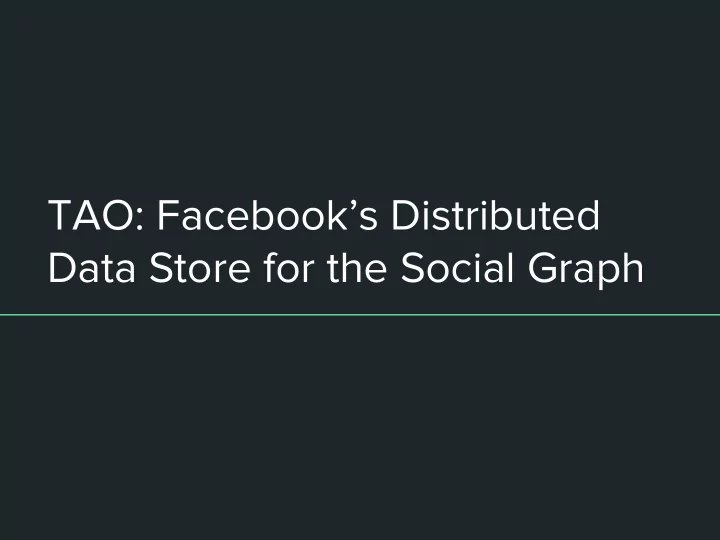

TAO: Facebook’s Distributed Data Store for the Social Graph
Before TAO Data stored in MySQL and cached in memcached Caching managed by apps Problems: ● Operations on lists are inefficient in memcached (update whole list) ● Complexity of clients managing cache ● Hard to offer read-after-write consistency
What is TAO? TAO is a storage system for graphs that manages both durability and caching ● Unlike memcached, it’s a write-through cache ● Unlike both memcached and MySQL, API explicitly involves graph concepts Eventually consistent, but “read-after-write” in many common cases
Data Model Objects (e.g. user, place) with unique IDs Associations (e.g. tagged) between two IDs Both have key-value data as well as a time field
API Create/delete/update objects and assocs Association queries: ● assoc_get(id1, atype, id2set, high?, low?) → list assocs between specific IDs ● assoc_count(id1, atype) → count assocs ● assoc_range(id1, atype, pos, limit) → list all assocs by position ● assoc_time_range(id1, atype, high, low, limit) → list assocs in time range After use, all results are filtered via privacy controls
Architecture MySQL databases → durability Leader cache → coordinates writes to each object Follower caches → serve reads but not writes
Partitioning Objects are allocated to fixed “shards” via their object ID; these may move across databases, etc after creation Associations (id1, atype, id2) stored on same shard as id1 One leader cache server is responsible for each shard and its assocs
Leader and Follower Caches Why two cache tiers? ● Quadratic growth in all-to-all connections for a single tier (because each server has to send writes to the server for their object ID) ● Hot spots ● Read-dominated workload Behavior ● All writes go to local and then master-region leaders ● These send updates to followers and the local leader that started the write (so that its clients can immediately see it) ● Updates across regions piggy-back on MySQL replication log ● Some possibility for inconsistency here
Consistency Consistency is eventual only; some reasons include: ● Master-slave replication of MySQL ● Cache followers can be behind leaders ● Some writes touch two items (e.g. maintaining inverse edges) However, TAO does try to provide “read-after-write” consistency when at most one failure occurs, by updating caches on the request path in-place ● Local leader, local follower, master leader, master MySQL
Workload Very read-heavy Most edge queries have empty results Long tails in most distributions
Recommend
More recommend